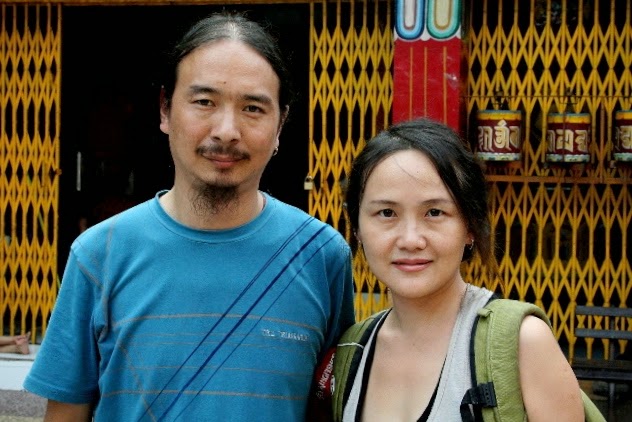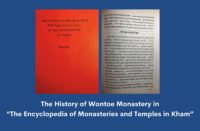
High Peaks Pure Earth has translated the second part of a blogpost by Woeser, originally written in August 2015 for the Mandarin service of Radio Free Asia and published on her blog on October 21, 2015.
Below, Woeser continues to write about her friend Tang Danhong‘s book project “Troubled Times: Voices of Tibetan Refugees” in which she and researcher Sangjey Kep travelled to Tibetan settlements in India, interviewing Tibetans.
Part One of the post can be found here: http://highpeakspureearth.com/2016/the-urgency-and-importance-of-eyewitness-testimonies-part-one-by-woeser/
Read the story of Chagdoe Donyon in English translation on China Digital Times.
“The Urgency and Importance of Eyewitness Testimonies”
By Woeser
Part Two
Eleven Tibetan eyewitnesses who recount their past experiences appear in the book “Troubled Times: Voices of Tibetan Refugees”; apart from one woman–the daughter of a resistance fighter–all of them are men, and all of them were resistance fighters. There is one of them, Chagdoe Donyon, I will never forget. This is not only because he is from Kham, the same hometown as my father and was also born in 1937, the same year my father was born, but more because when I saw his photo I was shocked to notice how much he also resembled my father. I read and re-read his oral accounts. He was the illegitimate child of a Princess from Derge. At the age of 13, he went to the Derge Imperial Palace at a time when my also 13-year-old father joined the military troops, leaving Derge for Chamdo. At 18, Donyon fled from Derge with his wife and parents and made a pilgrimage to Lhasa. Back then, my father was also in Lhasa, probably already a second lieutenant of the PLA. Later, Donyon became an important member of the “Chushi Gangdruk” trained by the CIA, leading a group of seven people to enter Tibetan airspace and organise and train resistance fighters. By that time, my father was already a high military officer working at the communications department for the Tibet Military Zone. If these two people from the same hometown, at the same age, looking so alike had met back then, they would have been bitter enemies. It is hard to even imagine this unlikely scenario; but it is certain that even if they had had something in common, they would have had to massacre each other.
Another witness is the official of the old Tibetan government Juchen Thubten Namgyal. He is also from Derge. In fact he is a relative of my father’s female cousin; more precisely, he is a relative of my father’s female cousin’s father and so he was not in direct blood relations to my father. However, I have never really understood this matter. When my father was still alive, I once asked him about their relationship, but he did not want to speak and I left it at that. Anyway, it is also not important whether the two were blood related or not, what I actually want to express is that after reading Juchen Thubten Namgyal’s oral account, I was overcome by complicated emotions. In terms of age, Juchen Thubten Namgyal was merely six years older than my father. But in real life, Juchen Thubten Namgyal took off his robes, became a guerilla fighter and left Derge to fight in Lhasa and other Tibetan areas. My father, as a PLA officer, was also in Lhasa and other Tibetan places; he did not go to war and only worked as a translator and took up an administrative post. And yet, the two men had already become bitter enemies.
I took particular notice of Juchen Thubten Namgyal’s accounts of the end of 1955 when so-called “democratic reform” was being implemented in Derge and public denunciations were daily fare, specifically demonising the religious. The royal family sent Juchen Thubten Namgyal to Lhasa to ask for armed support from the Tibetan government. But when he arrived in Lhasa he realised that “the Potala Palace, Jokhang and Ramoche Temples were embellished with butter lamps and the aristocratic officials were carrying out large-scale constructions, the noise of tamping machines was everywhere … the officials were doing big business, building new houses, singing and dancing, it was like one big happy festival.” It reminded me of Tsering Shakya’s book “The Dragon in the Land of Snows: A History of Modern Tibet Since 1947” in which he describes that when the Communist army entered Lhasa to “win over the patriotic upper class” they used the old silver dollar “Dayan” to crazily purchase Tibetan products. Members of the aristocratic families “saw this as an opportunity to make big money.” They readily sold land and accommodation, they sold grain and wool and happily enjoyed lavish banquets and ballroom dances organised by the PLA; every month they would send their servants back with horses loaded with bags full of “Dayan”. Sickening indeed.
In Autumn 2012, the Tibetologist Elliot Sperling published the article “The Body Count”. When I posted the Chinese translation on my blog, I promoted it as “an incredibly important essay; for history, for Tibet, for China; and of course, even more for humanity (this sentence should be specifically and forcefully directed at those so-called scholars who deliberately distort facts and who are mass murderers shaping humanity).”
In the article Sperling writes: “It is beyond dispute that there have been massive deaths in Tibet in the period between approximately 1950 and 1975 … the fact that a large-scale slaughter took place ought to be unquestioned”. However, “the matter of mass death in Tibet has rarely been raised within the PRC, at least officially, and then, only to rebut claims of such an occurrence.”
Mr. Sperling wrote this article because of photos that had been taken in May 2012 revealing mass graves in Nangchen county (Yushu Tibetan Autonomous Prefecture in Qinghai Province), showing human bones piling up, a ghastly sight. Local Tibetans exposed that this was where monks and laypeople had been massacred in 1958. “The past had come calling in the form of a mass grave. And the past was unconcerned about embarrassing the Chinese Government.” It is not only this mass grave that makes the eyewitness testimonies in “Troubled Times: Voices of Tibetan Refugees” ever more meaningful.
Mr. Sperling points out: “There are other ways in which the suppressed history of the slaughter breaks through the barrier of silence that the Chinese authorities have imposed on it.” The examples listed include a map displaying the collated data of China’s 1982 census; “the Tibetan Plateau, in 1982, had a widespread imbalance between males and females, an imbalance that can really only be explained by violent struggle. Across the entire PRC the Tibetan Plateau stands out in red as the largest expanse of territory in which the number of women so consistently outstripped that of men. And there among the red is Yushu…”. Two Tibetans who appear in “Troubled Times: Voices of Tibetan Refugees” are survivors from this red territory.
Mr. Sperling also says, “In the end, it is the records held by China that need to see the light of day. It is not enough to know, whether from direct personal accounts or indirect references in other sources, that something horrid and brutal took place in Tibet.” But of course, these records are still hidden secrets locked away and so today, the oral testimonies of survivors are ever more urgent and important. Just as the old Ratu Ngawang from Lithang said: “Chinese Communists have no belief, they forced Tibetans to destroy their monasteries. Headmen, Rinpoches and monks were accused of exploiting the people and thus massacred. They used the national army to suppress people in Kham and Amdo. They had guns, airplanes, bombs and so on, but we had no weapons other than those bought privately. The Tibetan people will never forgot that they ruthlessly massacred these helpless people, we will pass this history on from generation to generation. I will never forget this until I take my last breath.”
Tang Danhong and I first met when she opened her Kafka Bookshop in Chengdu. She is a typical Chengdu beauty. Her bookshop was located in an old vernacular alley that has by now been turned into a fake scenic spot. Inside the shop, I was drawn to the special shelf with books about Tibet; Danhong noticed it and came forward. It was the beginning of 20 years of deep friendship. Today, she lives far away in the Israeli city of Tel Aviv, while I live in China’s imperial capital. We have not met each other for 11 years.
Both Danhong and I were given the inborn passion and gift of writing poetry. Her documentaries are also extraordinarily valuable, documenting sky burials and Buddhist assemblies at Tsurphu Monastery, the young Karmapa and also Sershul County’s ecology and folklore. She has been to Lhasa many times, sometimes living with me. We would then go to the monastery, we would go out sightseeing or to eat Sichuan and Tibetan food.
We have so much in common; not only age, poetry and art; not only Sichuan dialect and not only our deep love for Tibet. My love comes from my flesh and bones–just as Danhong wrote in an email to me: “You love them because they are your family, I love them because of my mysterious connection with them…” But what unites us the most is our profound feeling of shame: She feels this shame because she is Chinese; I feel this shame because I am one-quarter Chinese and because my father was a PLA soldier. And because of this shame, we feel restless and even guilty. Because of this shame we want to make up for it through writing. This is also why, after the protests of March 2008, Danhong wrote the essay “Chinese views on Tibet: Tibet – Her Pain, My Shame”. She wrote: “18 years ago, when I set foot on Tibetan soil for the very first time, I could not imagine that I would ever feel such deep and inconsolable regret for the place and its people; I did not know that my encounter with Tibet bestowed this precious favour on my life; I also did not know that when I received Tibet’s comfort and compassion, another feeling dissipated throughout my body and mind, it was a feeling of pain that had nothing to do with me as an individual, but was related to the relationship between two ethnic groups: Chinese and Tibetans…”
Because of this shame, Danhong embarked upon the path of writing eyewitness literature. We hope to eliminate nations and nationalists; we want to eliminate power, colonialists and their “Damnatio memoriae”, just as suffering has always existed and keeps accumulating. And all of this can never be wiped away, it can even less be destroyed and glossed over through “Damnatio memoriae”. George Orwell, in “1984”, writes about the “unperson”, someone who has been vaporised and thus erased from existence. The oral accounts of the 11 Tibetans in “Troubled Times: Voices of Tibetan Refugees” tell how countless Tibetans were massacred and vaporised; they were once real, but then disappeared in physical or virtual mass graves as if they had never ever existed. And it is only through such eyewitness testimonies that these compatriots continue to exist.
Finally, I need to mention Sangjey Kyab from Amdo. He was born in the 1970s and became an exiled Tibetan of the new generation. He first left Tibet for Dharamsala and then settled down in Europe. Though we have never met, we have become good friends. I would like to thank him for his continuous help in translating Tibetan essays.
August 2015, Beijing





Follow Us!